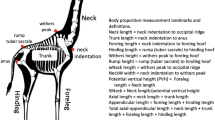Abstract
Some morphological and sexual characters were measured in juvenile, first-year and adult Red-necked Nightjars in SW Spain. We found significant age-related growth in wing, tail and body mass, first-year birds being heavier than adults. Adults showed sex differences in tail and wing lengths, and the size of tail and wing spots differed between males and females of all age classes. There was not any difference in the number of wing spots, and juvenile males had a lower number of tail spots than older males. An age-related increase in sexual dimorphism was found to exist by size increase of wing spots in males. Since wing and tail spots are exhibited in courtship displays, the elongation of these secondary sexual characters could be related to mate choice mechanisms.
Zusammenfassung
Einige morphologische Merkmale juveniler, einjähriger und adulter Rothals-Ziegenmelker (Caprimulgus ruficollis) in SW Spanien wurden gemessen. Es ergaben sich signifikante altersbedingte Unterschiede in Flügel- und Schwanzlänge sowie in der Körpermasse; einjährige Vögel waren schwerer als erwachsene. Adulte Vögel wiesen geschlechtsabhängige Unterschiede in der Flügel- und Schwanzlänge auf; die Größe der Schwanz- und Flügelflecken unterschieden sich zwischen Männchen und Weibchen aller Altersklassen. Es gab keine Unterschiede in der Anzahl der Flügelflecken; juvenile Männchen hatten aber weniger Schwanzflecken als ältere. Eine durch das Wachstum der Flügelflecken der Männchen bedingte Zunahme des Sexualdimorphismus wurde gefunden. Da die Flügel und Schwanzflecken bei der Balz eine Rolle spielen, könnte die Vergrößerung dieser sekundären Geschlechtsmerkmale mit Paarwahlmechanismen zusammenhängen.
Similar content being viewed by others
Literature
Anderson, M. (1982): Female choice selects for extreme tail length in a widowbird. Nature 299: 253–261.
Bortolotti, G. R. (1984): Age and sex variation in golden eagles. J. Field Ornithol. 55: 54–66.
Cramp, S. (1985): Handbook of the birds of the Western Palearctic. Vol. IV. Oxford.
Chandrine, J. W., &R. D. Morris (1989): Sexual size dimorphism and assortative mating in the Brown Noddy. Condor 91: 868–874.
Donazar, J. A., J. J. Negro &F. Hiraldo (1992): Functional analysis of mate-feeding in the Lesser KestrelFalco naumanni. Ornis Scand. 23: 190–194.
Ferrer, M., &C. de le Court (1992): Sex determination in the Spanish Imperial Eagle. J. Field Ornithol. 62: 359–364.
Francis, C. M., &D. S. Wood (1989): Effects of age and wear on wing length of Wood-Warblers. J. Field Ornithol. 60: 495–503.
Gargallo, G. (1994): Flight feather moult in the Red-necked NightjarCaprimulgus ruficollis. J. Avian Biol. 25: 119–124.
Green, P. T. (1982): Sexing Rooks (Corvus frugilegus) by discriminant analysis. Ibis 124: 320–324.
Höglund, J., M. Eriksson, &L. E. Lindell (1990): Females of the lek-breeding Great Snipe,Gallinago media, prefer males with white tails. Anim. Behav. 40: 23–32.
Ingels, J., &J. H. Ribot (1982): Variations in the white markings of the Blackish NightjarCaprimulgus nigrescens. Bull. Brit. Orn. Cl. 102: 119–122.
Jackson, H. D. (1984): Finding and trapping Nighjars. Bokmakierie 36: 86–89.
Ditto (1985): Aspects of the breeding biology of the Fierynecked Nightjar. Ostrich 56: 263–276.
Marti, C. D. (1990): Sex and age dimorphism in the Barn Owl and a test of mate choice. Auk 107: 246–254.
Martins, T. L. F., &J. Wright (1993): Cost of reproduction and allocation of food between parent and young in the Swift (Apus apus). Behav. Ecol. 4: 213–223.
Mengel, R. M. (1972): Wing clapping in territorial and courtship behavior of the Chuck-will's-widow and Poor-will (Caprimulgidae). Auk 89: 441–444.
Moller, A. P. (1994): Sexual selection and the Barn Swallow. Oxford.
Newton, I. (1989): Lifetime reproduction in birds. London.
Phillips, W. W. A. (1979): Nests and eggs of Ceylon Birds. 11. Trogoniformes, Apodiformes and Caprimulgiformes. Ceylon J. Sci. (Bio. Sci.) 13: 169–186.
Plumpton, D. L., &R. S. Lutz (1994): Sexual size dimorphism, mate choice, and productivity of burrowing owls. Auk 111: 724–727.
Soarez, A. A. (1973): SobreCaprimulgus europaeus eCaprimulgus ruficollis em Portugal. Museu Bocage Vol. 4: 214–233.
Tella, J. L., &I. Torre (1993): Sexual size dimorphism and determination of sex in the Chough (Pyrrhocorax pyrrhocorax). J. Orn. 134: 187–190.
Zar, J. H. (1984): Biostatistical analysis. New Jersey.
Author information
Authors and Affiliations
Rights and permissions
About this article
Cite this article
Forero, M.G., Tella, J.L. & García, L. Age related evolution of sexual dimorphism in the Red-necked NightjarCaprimulgus ruficollis . J Ornithol 136, 447–451 (1995). https://doi.org/10.1007/BF01651592
Issue Date:
DOI: https://doi.org/10.1007/BF01651592




